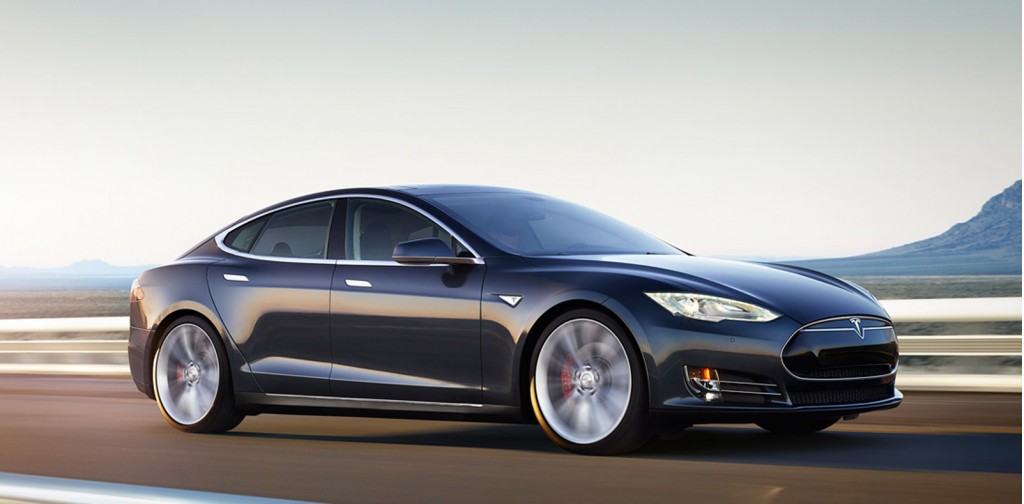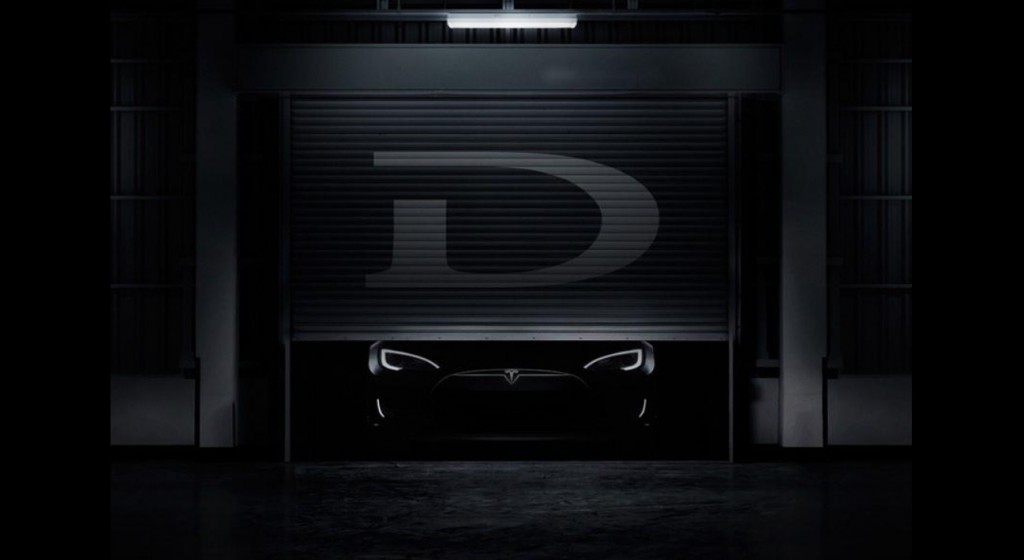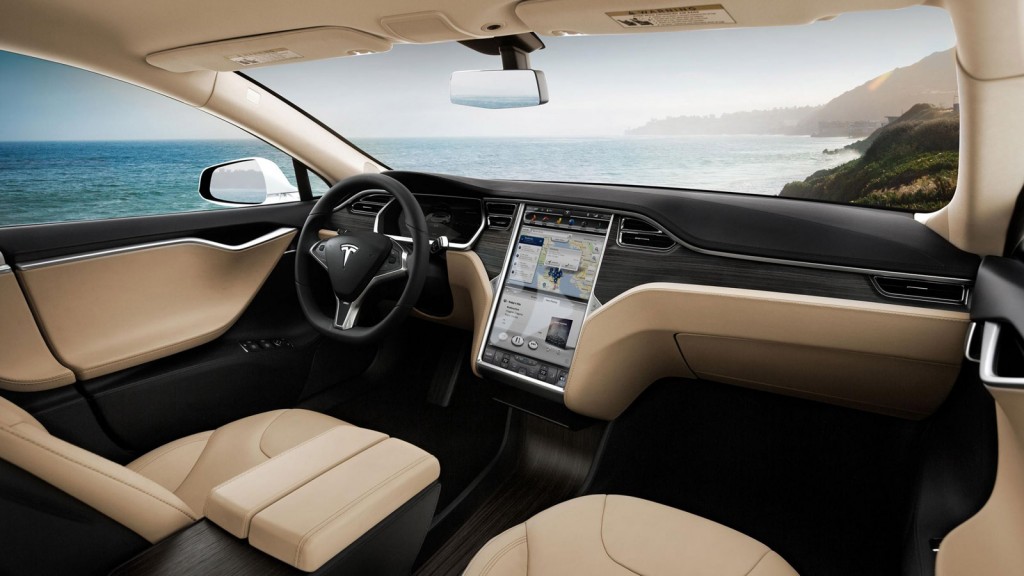
2014 Tesla Model S 'P85D' all-wheel-drive model
How can you add all-wheel drive to an electric car, making it hundreds of pounds heavier--and still increase its efficiency and range?
Amid all of last week's hoopla over the blazing performance of the all-wheel-drive Tesla Model S P85D--0 to 60 mph in 3.2 seconds, 155-mph top speed--what really caught my eye was this: Tesla accomplished it all while actually improving the efficiency of the car, despite a weight gain of almost 300 pounds.
[EDITOR'S NOTE: Please see author's update on page 3].
That's unheard of.
ALSO SEE: Tesla Reveals 'D' All-Wheel-Drive Model S, 'Autopilot' Feature
Every car powered by an internal-combustion engine loses efficiency when all-wheel drive is added. It's due to friction losses in the extra shafts and gears, as well as the additional weight.
A rear-wheel-drive BMW 328i, for example, drops from 27 mpg combined to 26 if you add the X-drive all-wheel-drive system.

Tesla Model S 'P85D' photo, uploaded to Tesla Motor Club forum by Adelman, October 2014
Standard 85D: even more efficient
In the standard 85-kWh Model S that most buyers will likely choose, Tesla's new AWD system boosts the range by anywhere from 4 to 19 percent--depending on which of Tesla's contradictory numbers you believe.
The official EPA combined range of the standard S-85 is 265 miles. On its website configurator, Tesla says the new AWD version will go 295 miles at 65 mph. (Temperature and climate-control use are not specified.)
DON'T MISS: Tesla Model S Adds 'Speed Assist,' Lane-Departure Warning
Though it's not quite an apples-to-apples comparison, that's an 11-percent improvement.
The range calculator on the Tesla website provides another basis for comparison. At a steady 65 mph, at 70 degrees with climate control on, the range calculator says the standard S-85 will go 242 miles.
By that yardstick, the range bonus for the 85D is even more astounding: 53 miles, or 19 percent.

Photo from Tesla 'D' tweet by Tesla Motors CEO Elon Musk, October 1, 2014
On the other hand, a blog post on the Tesla website says that both the 85D and 60D pick up an additional 10 miles of range over their single-motor counterparts.
That number is suspect on the face of it, however: With its smaller battery and shorter range, the 60D should have a proportionally smaller advantage over the standard 60-kWh model.
The most accurate comparison, however, may be that suggested by a speed vs range curve published in a 2012 blog post by Elon Musk and Tesle CTO JB Straubel on the Tesla website.
That curve shows the 85-kWh Model S to have a range of 262 miles at a steady 65 mph, the same condition ascribed to the 85D's 295-mile range. That's an increase of 33 miles, or 13 percent.
Take your pick: 30 miles of extra range, or 33 miles, or 53 miles...or 10 miles.
Whichever is correct, that's an impressive engineering feat.
Different AWD systems
As it turns out, the AWD system on the standard Model S 85D is markedly different from that of the much-ballyhooed P85D.
On the P85D, Tesla pretty much maintained the existing high-performance rear motor--at 350 kilowatts (470 horsepower)--and added an additional 165-kW (221-hp) motor up front.

Tesla Motors CEO Elon Musk delivers first Tesla Model S electric cars in Tokyo, Sept 2014
The result is a 47-percent increase in total power, to a mind-boggling 515 kW (691 hp). No surprise that performance went off the charts. It's a simple matter of power-to-weight ratio.
But something different is going on with the AWD version of the standard 85-kWh and 60-kWh versions of the Model S when D all-wheel drive is added.
MORE: Used Tesla Electric Cars: Certified Previously Owned (CPO) Program Coming, Company Confirms
The 85D and 60D replace the previously standard 285-kW (380-hp) rear motor with a pair of 140-kW (188-hp) motors, one front and one rear. That gives a total of 280 kW (376 hp), which is actually a slight decrease in total horsepower.
No details have been released yet about the new, less powerful motor fitted to those vehicles.
![Tesla Model S electric motor and drive unit [photo posted by user Tam to Tesla Motors forum] Tesla Model S electric motor and drive unit [photo posted by user Tam to Tesla Motors forum]](https://images.hgmsites.net/lrg/tesla-model-s-electric-motor-and-drive-unit-photo-posted-by-user-tam-to-tesla-motors-forum_100475357_l.jpg)
Tesla Model S electric motor and drive unit [photo posted by user Tam to Tesla Motors forum]
Is it merely a derated version of the current 285-kW motor, or something all new? A version of the 115-kW (154-hp) motor that Tesla provided to Toyota for the RAV4 EV? Or the 132-kW (177-hp) one provided to Mercedes for its B Class Electric Drive?
Despite the slight power cut, 0-to-60-mph time for the 85D falls from 5.4 to 5.2 seconds. Top speed rockets from 125 mph to 155 mph. And, of course, it's 4 to 19 percent more efficient.
So...how the heck did they do that?
Two-motor versatility
During the D reveal, Tesla Motors CEO Elon Musk gave a general idea of how this was accomplished.

Tesla Motors CEO Elon Musk reveals Tesla Model S 'D' all-wheel-drive system, Oct 2014
"Because we have two drive units, where we can shift the power from front to rear, and constantly be at the optimal efficiency point for each motor," Musk said, "we're actually able to overcome the penalty of the increased mass of the motor."
Later he elaborated for Bloomberg News: "We're able to balance the efficiency of the motors....If you have just one motor, it's always on a particular power-vs-efficiency curve."
"But if you have two motors, you can optimize between them, and have the motors operate in their more efficient regime more of the time."

2014 Tesla Model S
While Musk didn't get further into the details of this system, it's likely that one motor is optimized for powerful acceleration, the other for efficient high-speed cruising.
Presumably each has a gear ratio optimized for its primary duty. Power is then shunted to whichever motor is in the more efficient part of its power/efficiency curve and rpm range for the job at hand.
Single-motor compromise
Due to the rotating-speed limits of a single fixed-gear motor, Tesla designers originally had to choose between acceleration and top speed for the standard single-motor Model S.
They clearly chose acceleration, at the expense of top speed.
The single-motor 85-kWh Model S has a top speed of 125 mph--far slower than comparable sport sedans with similar power.
It's a flaw that's largely irrelevant to most U.S. buyers, but it has apparently hurt Model S sales in Germany, where the ability to cruise at 130 to 140 mph on the Autobahns is de rigueur in a car costing $100,000 or more.

2014 Tesla Model S
The new 85D , with two motors, has the best of both worlds.
We would presume the rear motor is geared low for quick acceleration, while the front motor pushes a taller "overdrive" gear for more efficient high-speed cruising.
The fact that top speed has jumped from 125 to 155 without a power increase suggests a radical change in gearing for at least one of the motors.

2014 Tesla Model S 'P85D' all-wheel-drive model
All in all, improving acceleration, top speed, and efficiency in a heavier car is an engineering tour de force that Tesla should be very proud of.
And it's one more example of the inherent superiority of the electric motor over combustion engines when it comes to the business of propelling a car.
We can picture engineers at BMW, Mercedes, and Audi pounding their heads on their desks in frustration.
You almost have to feel sorry for the poor guys still stuck working on those old-fashioned cars with combustion engines.
+++++
UPDATE: In the comments section, a sharp-eyed reader posted a link to a Tesla patent document describing a “control system for an all-wheel-drive electric vehicle.”
The document describes a system in which the two motors have different torque characteristics and gear ratios matched to different conditions, as we theorized above.
Each motor has what’s called a “base speed,” defined as “the speed at which the torque declines to 95 percent of the flat peak torque, and will continue to drop off....”
In other words, the base speed is the highest motor rpm at which the motor can provide nearly peak torque.
When gearing is taken into consideration, this rpm is called the “drive system base speed”--the highest wheel rpm (and therefore car speed) at which near-peak torque is available.
In one example cited in the document, the primary drive motor has a base speed at 7200 rpm. But the assist motor is designed to provide a “much higher” drive system base speed than that of the primary drive motor--either due to a torque curve that maintains its peak to a higher rpm, or due to higher gearing.
Preferably, the document says, the assist motor should have a drive sytem base speed “at least 50 percent higher” than that of the primary drive motor.
Of course the motors desribed in the document may or may not be the Model S motors. But the example gives a good eidea of Tesla’s general approach to dual-motor AWD systems.
_______________________________________________












